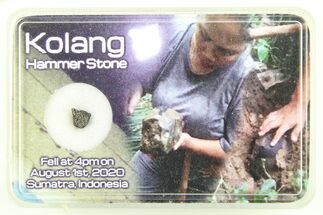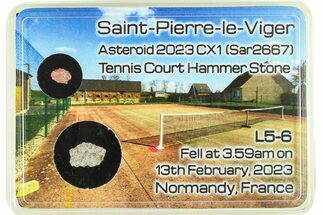This Specimen has been sold.
.13" Aguas Zarcas Chondrite Meteorite Fragment - 2019 Witnessed Fall
This is a neat specimen: a .13" wide hammer stone fragment of the incredibly rare Aguas Zarcas meteorite, a witnessed fall over Costa Rica on April 23, 2019. Comes with the pictured display case.
The Aguas Zarcas Meteorite
Shortly after 9:00 PM on April 23, 2019, a fireball lit up the sky over the town of Aguas Zarcas in central Costa Rica. The fireball then exploded, showering the area in meteorite fragments. Fragments even crashed into a doghouse! It shattered into hundreds of smaller fusion-crusted stones upon entry, mostly into angular pieces, though some oriented pieces have also been found. Six days after it fell, the area got rain: because so much was collected before and after the rain, scientists now have clear examples of what rain can do to fusion crusts on fresh meteorites. About 27 kilograms in total have been recovered.
Aguas Zarcas is classified as a CM chondrite, a rare kind of chondrite with fine-grained chondrules and matrices, as well as abundant hydrated minerals. It is highly brecciated, indicating a highly impacted parent body shaped by constant pummeling and accretion of asteroidal material. Its composition is similar to the famous Murchison meteorite from Australia. Aguas Zarcas even contains organic compounds, including sugar alcohols, carboxylic acids, and other hydrocarbons!
This meteorite is highly prized for both its rarity and scientific value: take home this astronomical find today!
Shortly after 9:00 PM on April 23, 2019, a fireball lit up the sky over the town of Aguas Zarcas in central Costa Rica. The fireball then exploded, showering the area in meteorite fragments. Fragments even crashed into a doghouse! It shattered into hundreds of smaller fusion-crusted stones upon entry, mostly into angular pieces, though some oriented pieces have also been found. Six days after it fell, the area got rain: because so much was collected before and after the rain, scientists now have clear examples of what rain can do to fusion crusts on fresh meteorites. About 27 kilograms in total have been recovered.
Aguas Zarcas is classified as a CM chondrite, a rare kind of chondrite with fine-grained chondrules and matrices, as well as abundant hydrated minerals. It is highly brecciated, indicating a highly impacted parent body shaped by constant pummeling and accretion of asteroidal material. Its composition is similar to the famous Murchison meteorite from Australia. Aguas Zarcas even contains organic compounds, including sugar alcohols, carboxylic acids, and other hydrocarbons!
This meteorite is highly prized for both its rarity and scientific value: take home this astronomical find today!
What Is A Hammer Stone?
Hammer stones are the names given to meteorite fragments that hit man-made objects, animals, or people when they fall. Hammer stones are often identified by the scuffed fusion crusts that can contain traces of paint, rubble, or other materials from the objects they hit. Because they are so rare, they are valued collectors' items. Often the items hammer stones hit go up in value, just be being damaged by a meteorite!
Hammer stones are the names given to meteorite fragments that hit man-made objects, animals, or people when they fall. Hammer stones are often identified by the scuffed fusion crusts that can contain traces of paint, rubble, or other materials from the objects they hit. Because they are so rare, they are valued collectors' items. Often the items hammer stones hit go up in value, just be being damaged by a meteorite!
About CM2 Carbonaceous Chondrites
Carbonaceous chondrites are a rare and scientifically significant type of stony meteorite, representing only about 4% of all meteorites found on Earth. These meteorites are considered to be some of the oldest materials in the solar system, dating back over 4.5 billion years. They are composed primarily of silicate minerals but are unique for their high levels of carbon, organic compounds, and water-bearing minerals, offering a glimpse into the conditions of the early solar system.
Theys are divided into several groups, including CI, CM, CR, CO, CV, and CK, each representing different compositions and histories. CI and CM chondrites are the most primitive and are often rich in organic compounds. CI chondrites, like the Orgueil meteorite, are extremely rare and contain the highest known concentrations of organic materials among meteorites.
A CM2 chondrite is a type of carbonaceous chondrite meteorite with a high abundance of carbon and water-bearing minerals. The “CM” classification stands for the "Mighei-type," named after a meteorite that fell in Mighei, Ukraine. The "2" in CM2 indicates a specific petrologic (textural) type, meaning it has experienced low levels of alteration from water or heat compared to other chondrites, preserving more primitive materials.
Carbonaceous chondrites are a rare and scientifically significant type of stony meteorite, representing only about 4% of all meteorites found on Earth. These meteorites are considered to be some of the oldest materials in the solar system, dating back over 4.5 billion years. They are composed primarily of silicate minerals but are unique for their high levels of carbon, organic compounds, and water-bearing minerals, offering a glimpse into the conditions of the early solar system.
Theys are divided into several groups, including CI, CM, CR, CO, CV, and CK, each representing different compositions and histories. CI and CM chondrites are the most primitive and are often rich in organic compounds. CI chondrites, like the Orgueil meteorite, are extremely rare and contain the highest known concentrations of organic materials among meteorites.
A CM2 chondrite is a type of carbonaceous chondrite meteorite with a high abundance of carbon and water-bearing minerals. The “CM” classification stands for the "Mighei-type," named after a meteorite that fell in Mighei, Ukraine. The "2" in CM2 indicates a specific petrologic (textural) type, meaning it has experienced low levels of alteration from water or heat compared to other chondrites, preserving more primitive materials.
TYPE
Carbonaceous Chondrite (CM2)
LOCATION
Alajuela, Costa Rica
SIZE
.13" wide
CATEGORY
SUB CATEGORY
ITEM
#285689
 Reviews
Reviews












